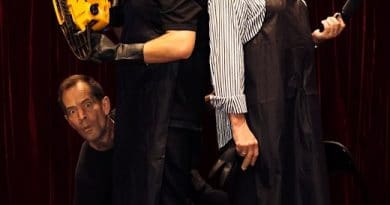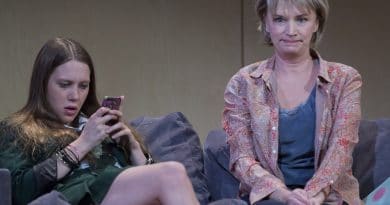Review: riverrun, Sydney Theatre Company
Olwen Fouéré’s riverrun, her winding monologue that brings shape to some part of the literary beast that is James Joyce’s Finnegan’s Wake, is a curious work that actively encourages you to turn off your brain.
It begins as a smooth, puzzling struggle.Fouéré is the voice of the river, taking her inspiration and the bulk of her text from the end of the book, when the river Liffey meets the sea, though she’s fashioned something that jumps around and chops and changes, and is stitched through with other passages.

Of course, it’s not really sensical; the rhythms are consistent and Fouéré is a lively storyteller, but the words are approximations of words, sounds and half-formed, half-discarded thoughts, a stand-in for the unconscious voice. You can’t catch every word. You won’t follow a story. That wasn’t Joyce’s intention, and it’s not really Fouéré’s priority, either. The priority is the evocation, like ritualising words in candlelight to bring luck or good fortune. The priority is the feeling, and the power that comes from feeling.
Fouéré is a river. The world is a river. And so it happens: the world starts to fall away.
So you must give in. You sit back, and let the words wash over you. There is a light to Fouéré, so formidable and so small that one expects more fragility from her. Instead she is sharp and warm. A tug of her lips, quirked upward, seems to suggest something the sort-of-words don’t quite; we laugh because she looks amusing or amused. When she darkens, we go with her.
The stage design is a suggestion of salt, a hint of a riverbed, with lighting by Stephen Dodd that manages to craft a Point A to Point B journey out of what amounts amount to wordless music (with sound design and composition by Alma Kelliher underscoring), lending needed shape to Fouéré’s full-body monologue. All the elements tie together in the vein of Fouéré’s fitted and tailored suit (designed by Monica Frawley and constructed by Monica Ennis) neatly and just a touch disheveled, perfect with a dash of nature’s unpredictability. It’s hard to dislike the craft of the work, especially technically.
As a satisfying, fulfilling work – well, I’m not sure that it is that. It is just slightly self-indulgent, but when Fouéré is so likeable, a good witch on stage, it’s hard to mind. Taken out of the context of its former placement as a festival work, it feels too flimsy, too inconsequential, too for the sake of not much else but beauty, for its place in the STC season. How much this bothers you, I think, depends on how much you want an experience that suggests something along the lines of something out-of-body. If you don’t mind an exercise in tuning out and sweeping majestically, never too swiftly, down a river, then I suspect this will be just the trick. It’s certainly something different. For a challenge, for a more robust meaning, for a piece that interrogates you – this one isn’t it. But there’s probably room for both in our lives.




